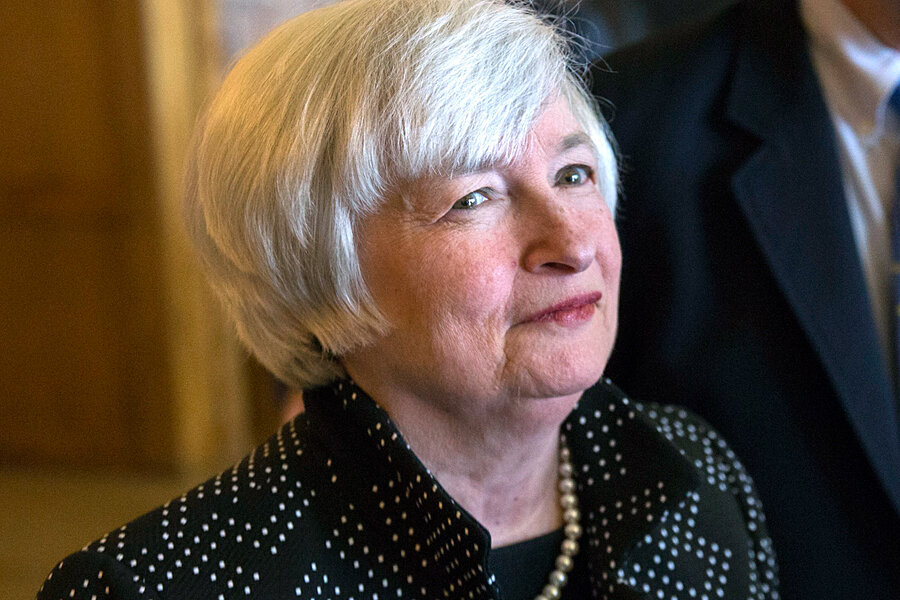When will Fed raise rates? Yellen talks a careful line.
Loading...
| Washington
At a time of growing speculation about a possible hike in interest rates, Federal Reserve Chair Janet Yellen waded cautiously Friday through a difficult issue: How will the Fed know when it’s time for that rate hike to happen?
It’s a question with big import for the US and world economies, which are currently growing but not exactly roaring on all cylinders. When the Fed raises its short-term interest rate for US banks – or even hints that it’s close to doing so – the event can send shockwaves through global financial markets.
In a speech at Jackson Hole, Wyo., Friday, Chair Yellen gave some expected signals – notably that she doesn’t see a rate hike as imminent, and that job market conditions, not just inflation, should play a crucial role in the decision.
But she also implied that policymakers aren’t perfect forecasters of their own actions.
Already, she noted, the labor market has been improving faster than the Fed’s policy committee expected. A rate hike could be called for, Yellen said, “if progress in the labor market continues to be more rapid than anticipated by the Committee or if inflation moves up more rapidly than anticipated.”
Her call for pragmatism seemed to sit well with investors. US stock markets were little changed as the closely watched speech – part of an annual conference of economists in the shadow of the Grand Teton mountains – was released.
Still, her comments underscore that the Fed is now in difficult and somewhat uncharted terrain.
The day of an interest-rate hike – anticipated currently to lie some time during 2015 – has been indisputably drawing closer. And economists say it’s far from assured that the Fed can navigate a gentle “exit” from its post-recession era of exceptionally low interest rates.
Yellen also emphasized how imperfect the Fed’s knowledge is. She emphasized various labor-data subtleties on both sides of the debate over whether the labor market is still “slack” and inflation pressures low.
“As a consequence” of this uncertainty, she said, “monetary policy ultimately must be conducted in a pragmatic manner that relies not on any particular indicator or model, but instead reflects an ongoing assessment of a wide range of information in the context of our ever-evolving understanding of the economy.”
Is that Fedspeak for, “we’ve got the finesse to handle this” or for “we really don’t know what we’re doing right now”? Even if the answer conveys a bit of inside-the-Fed anxiety, that’s not necessarily a bad thing.
Yellen is known as a thorough studier of the economy who doesn’t prejudge the right course for policy.
As of mid-year, a “dot plot” of Fed officials’ views suggests that the Fed’s short-term interest rate may rise from near zero today to 1 percent or so by the end of 2015, to about 2.5 percent by the end of 2016, and ultimately toward a long-run level of about 3.75.
Whenever a rate hike comes, there’s the question of what it will mean for the economy. Yellen and her colleagues want to be careful not to inflict harm on economic growth.
“Yellen seems content to normalize [interest rates] slowly until she sees the white in the eyes of inflation,” economist Tim Duy at the University of Oregon wrote prior the Jackson Hole speech.
Some economists say investor fears of dire outcomes when rates do start rising may be overblown.
“The economy should do well in the face of higher rates,” as long as the shift isn’t accompanied by some other shock such as from federal budget policy or the weather, Ethan Harris of Bank of America Merrill Lynch says in a report for clients this week.
Yellen, for her part, emphasized the Fed’s “dual mandate” from Congress is to set monetary policy based on the goal of full employment as well as inflation.
The balance of indicators, embodied in a Fed labor-market index, suggests that the current 6.2 percent unemployment rate “somewhat overstates the improvement in overall labor market conditions,” she said.
For example, as the job market improves, some people who are now counted as retired, in school, or disabled may return to the job market, for example. For now, those people are not counted as unemployed.
Yellen implied also that the Fed could allow long-subdued wage growth to pick up a bit “without exerting any meaningful upward pressure on inflation.”
Such wage growth may aid the cause of full-employment, she said, by helping to draw more Americans back into the job market. By contrast, tightening monetary policy as soon as inflation reaches the Fed’s target of about 2 percent a year could harm the economy, she said.
“[It] might, in this case, prevent labor markets from recovering fully,” she said, “and so would not be consistent with the dual mandate.”








